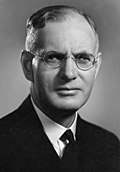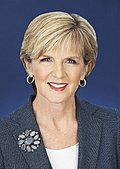Politics of Western Australia
 From Wikipedia - Reading time: 11 min
From Wikipedia - Reading time: 11 min
This article needs additional citations for verification. (May 2017) |
| This article is part of a series on the |
| Politics of Australia |
|---|
 |
| Constitution |
|
|
Western Australia politics takes place in context of a constitutional monarchy with a bicameral parliamentary system, and like other Australian states, Western Australia is part of the federation known as the Commonwealth of Australia.
The main parties are the governing Labor Party and the two Opposition parties (the National Party and the Liberal Party). Other minor political parties include the Greens, Western Australia Party, Shooters, Fishers and Farmers Party, Liberal Democratic Party, Legalise Cannabis WA Party, Pauline Hanson's One Nation and Australian Christians.[1] The other currently registered parties are Animal Justice Party, Democratic Labour Party, and Sustainable Australia Party – Anti-corruption.[2]
Premier of Western Australia
[edit]The premier of Western Australia is the head of government of the state of Western Australia. The role of premier at a state level is similar to the role of the prime minister of Australia at a federal level. The premier leads the executive branch of the Government of Western Australia and is accountable to the Parliament of Western Australia. The premier is appointed by the governor of Western Australia. By convention, the governor appoints as premier whoever has the support of the majority of the Western Australian Legislative Assembly. In practice, this means that the premier is the leader of the political party or group of parties with a majority of seats in the Legislative Assembly (lower house). Since Western Australia achieved self-governance in 1890, there have been 31 premiers. Roger Cook[3] is the current premier, having been appointed to the position on 8 June 2023.
State government
[edit]The nominal head of the Government of Western Australia is the King of Australia, represented in the state by the Governor of Western Australia. Legislative power rests with the Crown and the two houses of the Parliament of Western Australia. The powers and responsibilities of the parliament are defined in the Constitution Act 1889.[4]
Parliament of Western Australia
[edit]The Parliament of Western Australia is bicameral, consisting of a lower and an upper house.
The Western Australian Legislative Assembly (lower house) is composed of 59 members of parliament, each of whom represent a single electoral district and are elected using a preferential voting system. The Legislative Assembly sits for fixed four-year terms. The leader of the party with a majority in the Legislative Assembly (or with the confidence of the Assembly) is appointed by the Governor as the premier of Western Australia.
The Western Australian Legislative Council (upper house) has 36 members (or MLCs), representing six electoral regions. Six members are elected for each province using a proportional voting system.
General elections are held every four years, electing the entire Legislative Assembly and Legislative Council. The next state election is scheduled for March 2025.
Federal politics
[edit]| Western Australian seats in the Australian Parliament | ||
|---|---|---|
| Political party |
House of Representatives |
Senate |
| ALP | 9 | 5 |
| Liberal | 5 | 5 |
| WA Nationals | 0 | 0 |
| Greens | 0 | 2 |
| Independent | 1 | 0 |
| Source: Australian Electoral Commission | ||
Western Australia is divided into 15 federal electoral divisions, each represented by a seat in the Australian House of Representatives. Like other Australian states, Western Australia is represented by twelve Senators in the Australian Senate, with six of those Senators elected for two three-year Senate terms at each half-Senate election.
Historically, most federal elections have already been "decided"[a] by the time the polls close in Western Australia.[b] The only times since the mid-20th century when the state has decided an election were:
- 1998, when the first returns from the state assured a second term for John Howard
- 2010, when the victory of a state Nationals candidate who did not identify with the federal party allowed Julia Gillard to stay in office with a minority government
- 2022, when significant swings to Labor in a number of electorates helped Anthony Albanese become prime minister
Referendum results in Western Australia
[edit]This article is missing information about State-specific referendums. (October 2023) |
As of 2024[update], the most recent state referendum in Western Australia was in 2009.
| Year | No. | Name | National voters | States | WA |
|---|---|---|---|---|---|
| 1906 | 1 | Senate Elections | 82.65% | 6:0 | 78.93% |
| 1910 | 2 | State Debts | 54.95% | 5:1 | 72.80% |
| 3 | Surplus Revenue | 49.04% | 3:3 | 61.74% | |
| 1911 | 4 | Trade and Commerce | 39.42% | 1:5 | 54.86% |
| 5 | Monopolies | 39.89% | 1:5 | 55.84% | |
| 1913 | 6 | Trade and Commerce | 49.38% | 3:3 | 52.86% |
| 7 | Corporations | 49.33% | 3:3 | 52.84% | |
| 8 | Industrial Matters | 49.33% | 3:3 | 52.71% | |
| 9 | Trusts | 49.78% | 3:3 | 53.59% | |
| 10 | Monopolies | 49.33% | 3:3 | 53.19% | |
| 11 | Railway Disputes | 49.13% | 3:3 | 52.38% | |
| 1919 | 12 | Legislative Powers | 49.65% | 3:3 | 51.75% |
| 13 | Monopolies | 48.64% | 3:3 | 53.99% | |
| 1926 | 14 | Industry and Commerce | 43.50% | 2:4 | 29.29% |
| 15 | Essential Services | 42.80% | 2:4 | 25.90% | |
| 1928 | 16 | State Debts | 74.30% | 6:0 | 57.53% |
| 1937 | 17 | Aviation | 53.56% | 2:4 | 47.58% |
| 18 | Marketing | 36.26% | 0:6 | 27.77% | |
| 1944 | 19 | Post-War Reconstruction and Democratic Rights | 45.99% | 2:4 | 52.25% |
| 1946 | 20 | Social Services | 54.39% | 6:0 | 62.26% |
| 21 | Marketing | 50.57% | 3:3 | 56.21% | |
| 22 | Industrial Employment | 50.30% | 3:3 | 55.74% | |
| 1948 | 23 | Rents and Prices | 40.66% | 0:6 | 38.59% |
| 1951 | 24 | Communists and Communism | 49.44% | 3:3 | 55.09% |
| 1967 | 25 | Parliament | 40.25% | 1:5 | 29.05% |
| 26 | Aboriginals | 90.77% | 6:0 | 80.95% | |
| 1973 | 27 | Prices | 43.81% | 0:6 | 31.90% |
| 28 | Incomes | 34.42% | 0:6 | 25.21% | |
| 1974 | 29 | Simultaneous Elections | 48.30% | 1:5 | 44.07% |
| 30 | Mode of Altering the Constitution | 47.99% | 1:5 | 42.53% | |
| 31 | Democratic Elections | 47.20% | 1:5 | 42.86% | |
| 32 | Local Government Bodies | 46.85% | 1:5 | 40.67% | |
| 1977 | 33 | Simultaneous Elections | 62.22% | 3:3 | 48.47% |
| 34 | Senate Casual Vacancies | 73.32% | 6:0 | 57.11% | |
| 35 | Referendums | 77.72% | 6:0 | 72.62% | |
| 36 | Retirement of Judges | 80.10% | 6:0 | 78.37% | |
| 1984 | 37 | Terms of Senators | 50.64% | 2:4 | 46.47% |
| 38 | Interchange of Powers | 47.06% | 0:6 | 44.28% | |
| 1988 | 39 | Parliamentary Terms | 32.92% | 0:6 | 30.67% |
| 40 | Fair Elections | 37.60% | 0:6 | 32.02% | |
| 41 | Local Government | 33.62% | 0:6 | 29.76% | |
| 42 | Rights and Freedoms | 30.79% | 0:6 | 28.14% | |
| 1999 | 43 | Establishment of Republic | 45.13% | 0:6 | 41.48% |
| 44 | Preamble | 39.34% | 0:6 | 34.73% | |
| 2023[c] | 45 | Aboriginal and Torres Strait Islander Voice | 39.24% | 0:6 | 36.01% |
Notable Western Australia political figures
[edit]- John Forrest – first premier of Western Australia
- Edith Cowan – first Australian woman to serve as a member of parliament
- John Curtin – first and only Prime Minister of Australia to represent an electorate outside the eastern states
- Carmen Lawrence – first woman to become premier of a state of the Commonwealth of Australia
- Jo Vallentine – first person in the world elected to a parliament on a nuclear disarmament platform
- Mark McGowan – former premier of Western Australia
- Julie Bishop – first woman to be Foreign Minister and deputy leader of the federal Liberal Party
- Mia Davies – first woman to lead a branch of the Nationals at state or federal level and become State Opposition leader
- Ben Wyatt – first Aboriginal treasurer in an Australian state or federal government
- Ken Wyatt – first Aboriginal member of the House of Representatives and the first Indigenous federal minister
- Anne Aly – first female federal parliamentarian of Muslim faith
-
John Curtin
-
Mark McGowan
-
Julie Bishop
Recent state election results
[edit]| Primary vote | |||
|---|---|---|---|
| ALP | L+NP | Oth. | |
| 2001 Western Australian state election | 37.24% | 34.42% | 28.34% |
| 2005 Western Australian state election | 41.88% | 39.33% | 18.78% |
| 2008 Western Australian state election | 35.84% | 43.26% | 20.91% |
| 2013 Western Australian state election | 33.13% | 53.15% | 13.7% |
| 2017 Western Australian state election | 42.20% | 36.63% | 21.18% |
| 2021 Western Australian state election | 59.92% | 25.3% | 14.78% |
See also
[edit]Notes
[edit]- ^ Officially, the results of an election are declared by the Australian Electoral Commission only after all votes in all states have been counted. However it is common practice for the media, and the political parties themselves, to declare a winner based on the votes counted thus far.[5]
- ^ Polls close at 6pm local time, and vote counting starts in each state when polls are closed. WA has about 10% of Australia's population and is 1+1⁄2 hours behind South Australia and the Northern Territory, 2 hours behind the 80% of the population in the eastern states (plus 1 hour in summer, for the majority of states that observe daylight saving time, when WA does not). Consequently, when the results from states other than WA strongly favour either of the two major parties, the overall national "winner" can be determined independently of WA's results, even before WA's polls close.
- ^ Results for this referendum are preliminary, and percentages may change, however the result is not expected to change.
References
[edit]- ^ "Australian Christians | Political Party | WA". Australian Christians Political Party WA. Retrieved 31 August 2023.
- ^ "Registered Political Parties in WA | Western Australian Electoral Commission". www.elections.wa.gov.au. Archived from the original on 2024-10-14. Retrieved 2025-01-12.
- ^ "New Cook Cabinet team unveiled". Government of Western Australia. 7 June 2023.
- ^ Constitution Act 1889
- ^ The count: Declaring results. Australian Electoral Commission. 2021-08-26. Retrieved 2023-10-21.
- ^ Handbook of the 44th Parliament (2014) "Part 5 – Referendums and Plebiscites – Referendum results". Parliamentary Library of Australia..
This article needs additional citations for verification. (October 2012) |
 KSF
KSF

